Practising for your motorcycle licence test can feel a bit overwhelming at first, especially if you’re not sure what to expect on the day. That’s why setting up a mock road scenario can make a real difference. It gives you the chance to build up your confidence, get familiar with how the test flows, and iron out any issues before the real thing. The idea is to take some of that test-day pressure off by getting used to doing everything in a controlled, safe space.
Realistic practice helps you see where you’re strong and where you need a bit more work. It’s about building good habits and making the right moves feel natural. By putting yourself through test-style situations like intersections, U-turns and slow riding, you’ll be better prepared for the road ahead. Here’s how to build your own practical scenarios and ride through them with purpose.
Choosing The Right Practice Location
Picking the right spot can make or break your practice session. First off, you’ll want somewhere quiet, flat and free from traffic. An empty car park is a great place to start. Look for one with plenty of space so you’re not cut short when practising turns or sudden stops.
Once you’ve got a good location sorted, it’s time to set the area up the right way. Here are a few tips to help you turn an open space into your own mock test circuit:
– Use rubber cones, chalk lines or empty drink bottles to mark lanes, stops and turns
– Try to create clear paths to practise riding straight, weaving and turning at intersections
– Add start and stop points so you can go through full sequences without guessing where to begin or end
– Make sure the surface is clean, dry and free from gravel or anything slippery
If possible, try to practise in spots with a bit of variety. Riding on different surface types like smooth bitumen, patchy pavement or even a slight slope can give you better control when things don’t feel perfect. This is especially handy towards the end of winter when road conditions can be unpredictable, with puddles and uneven surfaces hanging around a bit longer.
Before each session, do a walk-through of your space. It helps you spot hazards and make sure your markers are still where they should be. Keep an eye out for debris or oil spots and move anything that could mess with your wheels. Every ride will go smoother when you’ve set yourself up with a smart and safe environment.
Key Elements To Include In Your Mock Road Scenarios
Once you’ve got your space and markers sorted, it’s time to think about what exactly you’ll be practising. The goal is to copy the flow of an actual motorbike test as closely as you can. That means adding in the same types of challenges you’ll face when someone’s scoring your ride.
Start with these basics to build a strong mock test scenario:
– Intersections: Create a few junctions with cones or chalk to practise checking, signalling and safely entering or crossing. Practise both giving way and continuing straight through
– U-turns: Mark a tight U-turn zone, making sure it’s tricky enough to test your control but doable with practice. Focus on balance and speed control
– Emergency stops: Work in a clear stopping point where you can simulate needing to pull up quickly without skidding or losing control
– Traffic signs and cues: Toss in makeshift STOP or GIVE WAY signs, or even just use chalk to draw them on the ground. It helps train your mind to react to signage
– Pedestrian or vehicle presence: If you’ve got a mate helping, ask them to walk across your area or stand at intersections. Their presence can mimic real-life choices, like giving way or staying alert
Try switching up the order of activities so you’re not just going through the motions. Treat each practice run seriously and challenge yourself not to rely on muscle memory. The more you treat it like the real deal, the more natural everything will feel come test day.
Practising Specific Test Skills
Once you’ve built a solid mock setup, the next step is running through the exact skills the test covers. These aren’t just random drills. Each one targets a part of the test where riders can easily lose marks if they aren’t ready. Practising them regularly helps your handling become more precise, and your confidence more consistent, especially under pressure.
One area most new riders struggle with is slow-speed manoeuvring. This includes things like tight turns, figure-eights and controlling balance while moving slowly. Set up a few cones or bottles and work on weaving through them. Keep your head up and eyes forward, not on the ground. That alone can help with balance and stopping over-corrections. Pulling in your clutch slightly and managing your rear brake helps smooth things out.
U-turns and cornering also take a bit of finesse. It’s not about speed, it’s about throttle control and body positioning. Practise cornering by setting up wide and tight curves and focus on looking where you want to go. Weight the outside peg slightly and let the bike lean naturally. Make sure you’re not coasting through without proper checks. Treat it exactly like you would on test day.
Braking is another key focus. Mix up your emergency stops and gradual slow-downs. Practise stopping suddenly without locking the wheels, always using both brakes evenly. It’s worth starting at lower speeds and building up as you get smoother. Include some braking while cornering once you’re steady on your feet, so you get used to keeping control through awkward scenarios.
Mistakes will creep in during practice, that’s normal. The important bit is knowing what’s going wrong and fixing it. Here’s a quick list of common mistakes and how to correct them:
– Gripping the bars too tightly: relax your hands and arms to avoid jerky movements
– Forgetting mirror or head checks: add them into every movement so they become second nature
– Rushing manoeuvres: focus on control, not speed
– Hesitating during intersections: ride with purpose and trust your setup
– Overusing the front brake only: this can cause skidding, balance both
When something’s not clicking, don’t keep doing the same thing. Stop for a minute, readjust your setup and try again with intent. A small fix now could save you a test-day slip-up later.
Evaluating Your Practice Sessions
Practising won’t mean much if you’re not honest about how well you’re doing. Whether you’re riding solo or with someone giving feedback, it helps to set clear goals for each session and check how you measured up after each round. The aim is steady improvement, not overnight perfection.
One simple way to track your progress is keeping a logbook of your sessions. Note what went well and where things got shaky. Date each entry and track what you practised, like whether your U-turns stayed tight and clean or if your emergency stops took too long to feel natural. Patterns will show up quickly, which makes it easier to know what to focus on next time.
You could also ask a more experienced rider to watch and offer tips, especially for things you might miss like posture or head checks. Someone who’s done the test before can usually spot the little gaps that trainers or test officers would pick up. Don’t treat feedback as criticism, use it to steer your next session.
Mixing up your environment now and then also helps. Try the mock test in new car parks or different surface types once you’re comfortable. With each change, the same basics still apply but your reaction time and control will grow stronger. It’s a good way to push your limits without rushing into risky territory.
Most importantly, build your sessions up gradually. Stretch yourself where it makes sense, but don’t wear yourself out. Balance intense days with lighter sessions. Consistent practice with a clear goal always wins over random drills without structure.
Keep Riding Towards That Pass
The more time you spend rehearsing real-world riding conditions, the more second nature everything becomes. Your goal isn’t to memorise steps but to feel comfortable making safe choices on the fly. A proper practice setup gives you that edge. It helps you stay calm and focused when it matters most.
You’ve put the work in, built real confidence in traffic situations and polished each element of the motorcycle practice test. That doesn’t make test day easy, but it does make it familiar. When you’ve already handled the scenarios in your own mock setups, the test starts to feel more like just another ride. So keep turning up, keep putting in the time and trust what you’ve practised.
Ready to boost your riding skills and tackle your licence test with confidence? At Stay Upright, our motorcycle practice test options are designed to help you sharpen your technique and feel calm under pressure so you can ride into test day feeling prepared.



